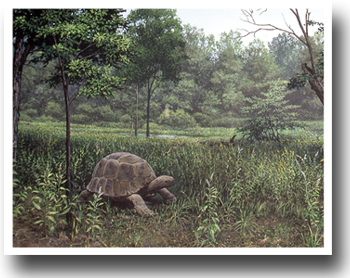
Interglacial Forest and Prairie, Montgomery County, 124,000 Years Ago
The Sangamon Interglacial was a period of warm climate that occurred after the last Illinois glaciation. Ice sheets had extended far into Illinois. Only the Shawnee Hills to the south, Jo Daviess County in the northwest, and a small piece of west-central Illinois were not covered at some time by ice. After the glaciers melted, flat deposits of glacial sediment were left behind. As the climate warmed, deciduous forests and grasslands grew on the deposits. Many of the plant species were the same as those common in Illinois today. Giant tortoises indicate winter temperatures were mild.
This reconstruction depicts a summer day in south-central Illinois. It is based on geological deposits and fossils from the Hopwood Farm site in Montgomery County, Illinois.
Climate
Illinois was about 40 degrees north of the equator—its current location.
The climate was warmer than today.
Geology
South-central Illinois glacial deposits are marked by low ridges up to
4 kilometers (2.5 mi.) wide and 1 to 35 kilometers (0.6–22 mi.)
long. The shape and structure of these sand and gravel ridges indicate
they were formed by water flowing in channels beneath the glacial ice.